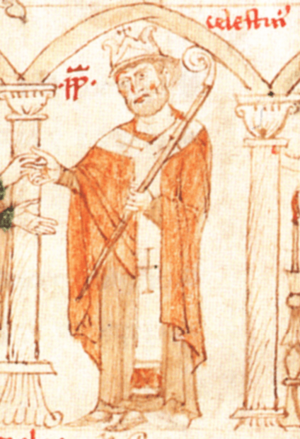Pope Celestine III facts for kids
Quick facts for kids Pope Celestine III |
|
|---|---|
| Bishop of Rome | |

Pope Celestine III, from the Liber ad honorem Augusti (1196)
|
|
| Church | Catholic Church |
| Papacy began | 30 March 1191 |
| Papacy ended | 8 January 1198 |
| Predecessor | Clement III |
| Successor | Innocent III |
| Orders | |
| Ordination | 13 April 1191 |
| Consecration | 14 April 1191 by Ottaviano di Paoli |
| Created Cardinal | February 1144 |
| Personal details | |
| Birth name | Giacinto Bobone |
| Born | c. 1106 Rome, Papal States |
| Died | 8 January 1198 (aged 91–92) Rome, Papal States |
| Previous post | Cardinal-Deacon of Santa Maria in Cosmedin (1144–1191) |
| Motto | Perfice gressus meos in semitis tuis ("Going in Thy path") |
| Signature | |
| Other Popes named Celestine | |
Pope Celestine III (Latin: Caelestinus III; c. 1106 – 8 January 1198), was the head of the Catholic Church and ruler of the Papal States from 30 March or 10 April 1191 to his death in 1198. He had a tense relationship with several monarchs, including Emperor Henry VI, King Tancred of Sicily, and King Alfonso IX of León.
Contents
Early career
Giacinto Bobone was born into the noble Orsini family in Rome. He was appointed as cardinal-deacon in 1144 by Celestine II or Lucius II. Considered by the Roman Curia as an expert on Spain, Bobone conducted two legatine missions to Spain in (1154–55) and (1172–75) as the Cardinal-Deacon of Santa Maria in Cosmedin.
Pontificate
Celestine was elected on 29/30 March 1191 and ordained a priest 13 April 1191. He crowned Emperor Henry VI on the day after his election in 1191. In 1192, Celestine recognized Tancred as king of Sicily, despite Henry VI's wife's claim. He threatened to excommunicate Henry VI for wrongfully keeping King Richard I of England imprisoned, but he could do little else since the College of cardinals were against it. He placed Pisa under an interdict, which was lifted by his successor, Innocent III in 1198.
Celestine, in 1192, sent a cardinal-priest of St. Lorenzo, Cinthius, to Denmark to address the discord between the Danish princes. Upon Cinthius' return to Rome, Celestine issued three papal bulls;Cum Romana ecclesia, Etsi sedes debeat, Quanto magnitudinem tuam. These bulls advised the archbishop Absalon of Lund to instruct the King of Denmark to release the bishop of Schleswig. The bulls also threatened to excommunicate the offending Duke Valdemar, who had imprisoned the bishop of Schleswig, and place the kingdom of Denmark under interdict. The bishop would stay imprisoned until Pope Innocent III restarted the process in 1203.
Celestine condemned King Alfonso IX of León for his marriage to Theresa of Portugal on the grounds of consanguinity. Portugal and León were placed under interdict. Then, in 1196, he excommunicated Alfonso IX for allying with the Almohad Caliphate while making war on Castile. Following his marriage with Berengaria of Castile, Celestine excommunicated Alfonso and placed an interdict over León.
In December 1196, Celestine issued a bull acknowledging the possessions of the Teutonic Knights.
Death
Celestine would have resigned the papacy and recommended a successor (Cardinal Giovanni di San Paolo, O.S.B.) shortly before his death, but was not allowed to do so by the cardinals.
See also
 In Spanish: Celestino III para niños
In Spanish: Celestino III para niños
- List of popes
- Cardinals created by Celestine III

